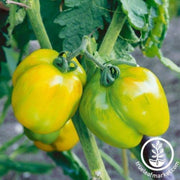Out Of Stock!
We will notify you when this product becomes available.
Tomato Seeds - Slicing - Stuffer Green
85 Days to maturity (from transplant). Solanum lycopersicum. Stuffer Green Tomato Seeds. Non-GMO, warm season annual, open-pollinated, heirloom, indeterminate, slicing tomato. Suitable for growing in garden plots, raised beds, and greenhouses. These three-inch large fruits greatly resemble green peppers! Approx. 6,800 seeds/ounce.




Download Free Vegetable Growing Guide PDF
Growing Stuffer Green Tomatoes in the Vegetable Garden
Growing tomatoes from seed is a rewarding process that allows for control over the entire life cycle of the plant. To start, choose a well-draining and nutrient-rich seed-starting mix for sowing the tomato seeds. Optimal germination occurs when the soil temperature is between 75 and 85 degrees Fahrenheit. Plant the seeds indoors, typically 7-9 weeks before the last expected frost date in your region, using containers with adequate drainage holes.
Heirloom tomatoes, with their unique characteristics, require special attention during the germination phase. For green-harvested varieties, such as 'Stuffer Green,' selecting heirloom seeds ensures the preservation of distinctive traits. When planting heirloom tomato seeds, maintain a warm and consistently moist environment to encourage robust germination. Heirlooms often have a longer germination period, so patience is key.
Once the seedlings have grown to about 2 inches in height and developed their first set of true leaves, it's time to transplant them into larger individual pots. This allows the plants to establish strong root systems which, in turn, improves establishment in the outdoor garden. Maintain a consistent temperature and provide ample sunlight or supplemental light to promote healthy growth. Prior to transplanting the seedlings outdoors, it's crucial to harden them off. This involves gradually acclimating the plants to outdoor conditions. Start by placing them in a sheltered spot for a few hours each day, gradually increasing the duration over a week or two. This process toughens the plants, preparing them for the outdoor environment.
When transplanting heirloom tomato plants, select a sunny location with well-drained soil. Heirlooms often benefit from richer soil, so composting the planting area is advisable. Proper spacing between plants is essential for air circulation and preventing diseases.
For heirloom tomatoes meant to be harvested green, like 'Stuffer Green,' attentive care is crucial during the growing season. Regularly check for signs of pests or diseases and promptly address any issues. Fertilize the plants with a balanced, organic fertilizer to provide the necessary nutrients for robust growth.
Growing heirloom tomatoes from seed demands a balance of patience, care, and attention to specific needs. By starting with quality seeds, ensuring proper germination conditions, and providing ongoing care tailored to the unique characteristics of heirlooms, you can cultivate robust and flavorful tomato plants that stay true to their heritage.
Harvesting Stuffer Green Tomatoes
Harvesting tomatoes at the green stage is essential for certain varieties that exhibit optimal flavor and texture when unripe. Pick these tomatoes before they reach full ripeness, ensuring a tangy and crisp taste. Harvesting is typically done when the fruits have reached their mature size and display a vibrant green hue. Store them in a cool, dark place to allow for gradual ripening. These green tomatoes are versatile, lending themselves to pickling, frying, or incorporating into relishes, providing unique culinary experiences with their distinctive flavor profile.
About Stuffer Green Tomato Garden Seeds
Stuffed green tomato recipes involve filling the tomatoes with a variety of ingredients such as spices, herbs, and other vegetables and then baking or cooking them. The "Stuffer Green" tomato is valued for its firm texture and ability to hold fillings well, making it a popular choice for stuffed tomato dishes.
These three-inch large fruits resemble green peppers! The seeds appear in a cluster near the top of the fruit, so the fruit's insides are easily removable for quick and straightforward stuffing!
Cooking green tomatoes offers a delightful twist to traditional recipes. Commonly associated with Southern cuisine, fried green tomatoes are a classic favorite, featuring a crispy coating that complements the tangy interior. Alternatively, pickled green tomatoes add zing to salads and sandwiches.
Green tomato chutney or relish introduces a sweet and savory dimension, making it a versatile condiment. Grilled or roasted green tomatoes contribute a smoky flavor to dishes. Experimenting with green tomatoes allows for a range of culinary creations, showcasing their unique taste and adding a vibrant touch to diverse meals, proving that the unripe stage can be just as delicious as ripe tomatoes.
Preserving green tomatoes opens the door to a world of tangy delights. Pickling green tomatoes in a brine or vinegar solution imparts a flavorful kick, perfect for snacks or garnishes. Green tomato jam or relish, often infused with spices, offers a sweet and savory addition to various dishes. For longer storage, consider freezing slices or whole green tomatoes, maintaining their unique taste for future culinary endeavors. These preservation methods not only capture the distinct flavors of unripe tomatoes but also ensure a continued supply, allowing you to savor their zesty essence throughout the seasons.
Stores From Our Gardeners
"Fried Green Tomatoes are very nostalgic to me. I was born in the South and much of my family still lives there. Many of them grow tomatoes with the exclusive goal of getting green tomatoes to fry!"
 |
- Lara Wadsworth, True Leaf Market Writer |
Other Resources
Stuffer Green Tomato Seeds Per Package:
- 300 mg packet - Approximately 65 Seeds
- .25 oz - Approximately 1,700 Seeds
- 1 oz - Approximately 6,800 Seeds
- 4 oz - Approximately 27,200 Seeds
- 1 lb - Approximately 108,800 Seeds
Non-GMO Stuffer Green Tomato seeds are available for Fast Free Shipping on qualifying orders.
Basic Info
| Latin Name: | Solanum lycoperscium (previously Lycopersicon esculentum) |
| Tomato Type: | Slicing - Larger, round tomatoes, the size of your fist or larger. |
| Stuffer Green Tomato Color: | Green, Yellow |
| Stuffer Green Tomato Flavor: | mild |
Growing Info
| Hardiness Zone: | 2, 3, 4, 5, 6, 7, 8, 9, 10, 11 Annual: Not intended to overwinter |
| Days to Maturity: | 85 (from transplant) |
| Days to Germination: | 7-10 |
| Seeding Depth: | 0.25 inch |
| Plant Spacing: | 24-36 inches |
| Row Spacing: | 36 inches |
| Plant Height: | 36-96 inches |
| Growth Habit: | Indeterminate - Indeterminate tomatoes are vine-type plants that sprawl (requiring a cage or trellis to support them) and continue to grow throughout the season. Indeterminate tomato plants will continue to produce tomatoes for the rest of the season, so you can harvest continually. |
| Soil Preference: | Well-draining, loose (sandy loam), slightly acidic (6.2 to 6.8), and moisture retaining. Too much nitrogen in the soil may lead to more foliage production and less fruiting. Tomatoes like more phosphorus and potassium than other vegetables. |
| Temperature Preference: | Warmer (70-85 F) |
| Light Preference: | Full Sun |
Other
| Direct Sow: | No |
| Start Indoors: | Yes. Start Indoors 7-9 weeks before your last spring frost date. |
| Plant Width: | 24 inches |
| Plant Spread: | 24 inches |
| Growth Speed: | Late - Ready to harvest from 81 days or more from transplant. Difficult, if not impossible, to get a tomato by the 4th of July with these varieties. They are good late-summer to early-fall producers for most USDA Zones. |
| Germination Temperature: | 65-85 F |
| Pests and Diseases: | Common pests known to harm tomato plants, in general, include the tomato hornworm, cutworm, aphids, flea beetles, tomato fruit worms, and whiteflies. Also, watch for common diseases such as blossom end rot, fusarium wilt, powdery mildew, verticillium wilt, late blight, bacterial canker/spot, and tobacco mosaic virus. Most of these can be prevented by maintaining a regular watering schedule and avoiding overwatering. Regularly check your plants for pest damage throughout the season. For treating pest and disease problems, we recommend using an organic neem-based product. |
| Garden Size: | Greenhouse, Garden Plot, Raised Bed |
| Tomato Use: | Salads, fresh eating, slicing |














